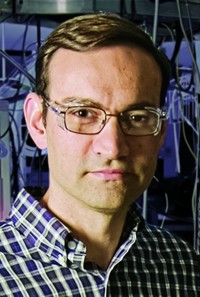Advertisement
Grab your lab coat. Let's get started
Welcome!
Welcome!
Create an account below to get 6 C&EN articles per month, receive newsletters and more - all free.
It seems this is your first time logging in online. Please enter the following information to continue.
As an ACS member you automatically get access to this site. All we need is few more details to create your reading experience.
Not you? Sign in with a different account.
Not you? Sign in with a different account.
ERROR 1
ERROR 1
ERROR 2
ERROR 2
ERROR 2
ERROR 2
ERROR 2
Password and Confirm password must match.
If you have an ACS member number, please enter it here so we can link this account to your membership. (optional)
ERROR 2
ACS values your privacy. By submitting your information, you are gaining access to C&EN and subscribing to our weekly newsletter. We use the information you provide to make your reading experience better, and we will never sell your data to third party members.
People
A Nobel Birthday Surprise
German chemist nabs prize for surface science on his 71st birthday
by Bethany Halford
October 10, 2007

Gerhard Ertl certainly had cause to celebrate on his 71st birthday. Along with gifts and warm regards, Ertl received the news that he'd been awarded the 2007 Nobel Prize in Chemistry for his pioneering studies of chemical processes on solid surfaces. He will claim his extra-special birthday surprise—a gold medal and $1.5 million—on Dec. 10 in Stockholm.
Ertl, professor emeritus at the Fritz Haber Institute of the Max Planck Society, in Berlin, said in an interview with the Nobel Foundation that he was particularly honored to be the first surface scientist to receive the Chemistry Nobel since the legendary Irving Langmuir garnered the award in 1932.
The Nobel Committee singled out Ertl for his studies of fundamental processes at the gas-solid interface. He developed a quantitative description of how hydrogen organizes itself on the surfaces of catalytic metals such as platinum, palladium, and nickel. Ertl also produced key insights into the mechanism of the Haber-Bosch process, in which nitrogen and hydrogen combine to form ammonia.
"I am delighted that the prize recognizes a field of chemistry that often receives little public attention and yet has transformed lives in so many ways," notes Catherine T. Hunt, president of the American Chemical Society. "This prize honors basic research. As chemists, we know that's important, but it's wonderful to be able to broadcast that to the larger community," she tells C&EN.
"Ertl has done some of the most elegant high-vacuum surface science that has ever been carried out," comments Harvard University chemistry professor George M. Whitesides. "His work is the best of fundamental science-technically impeccable, technically very challenging, carried out with very high scientific standards, and sometimes very unexpected in what it has produced.
"This work, along with that of others in the ultrahigh-vacuum surface-science community, especially that of [University of California, Berkeley, professor] Gabor A. Somorjai, developed much of the technology of this area of science and has taught us most of what we know about the structure and reactivity of organic and organometallic molecules on metal surfaces under conditions relevant to heterogeneous catalysis," Whitesides adds.
"I think Ertl's award is just abundantly deserved," says Ralph Nuzzo, a chemistry professor at the <!-- InstanceBeginEditable name="mainContent" -->University of Illinois, Urbana-Champaign<!-- InstanceEndEditable -->. "There are very few people who have made such a broadly reaching impact."
Although it's basic science, Ertl's work has far-reaching implications, both industrially and environmentally. The Haber-Bosch process is used to make artificial fertilizers by converting nitrogen from air into ammonia, using an iron surface as a catalyst. To clean exhaust emissions, all modern automobiles contain a platinum catalyst that oxidizes carbon monoxide and hydrocarbons to carbon dioxide via surface chemistry. Even simple rust is an example of a chemical process on a surface. By understanding these chemical processes, Ertl explained, scientists can think of ways to improve them.
Ertl also said that he always advises his pupils to never abandon their work. "You should always try to solve a problem as far as it is possible," he said, adding, "You must be patient; that's very important."
Charles T. Campbell, a chemistry professor at the University of Washington, Seattle, who studied with Ertl as a postdoctoral fellow, says he's been expecting that Ertl would win the prize. "He's just so intelligent about designing good experiments that uncover the deepest secrets of how nature is operating," Campbell says.





Join the conversation
Contact the reporter
Submit a Letter to the Editor for publication
Engage with us on Twitter